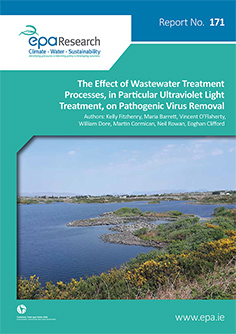Research 171: The Effect of Wastewater Treatment Processes, in Particular Ultraviolet Light Treatment, on Pathogenic Virus Removal
Authors: Kelly Fitzhenry, Maria Barrett, Vincent O’Flaherty, William Dore, Martin Cormican, Neil Rowan, Eoghan Clifford
Summary: This study investigated the use of an alternative virus (FRNA bacteriophage) as a potential surrogate/model for norovirus behaviour.

Municipal wastewater treatment plant discharges are a recognised source of human pathogenic viruses.
Of concern within this group is norovirus the leading cause of viral gastroenteritis worldwide. This project investigated the use of FRNA bacteriophage as (i) a potential surrogate for norovirus response/behaviour and (ii) a model to determine the fate of viruses through a municipal wastewater treatment plant. The project also evaluated the efficacy of membrane filtration (microfiltration and ultrafiltration) as pathogen removal method and two ultraviolet-based technologies; pulsed UV and low pressure UV as pathogen disinfection methods. The potential impacts of parameters suchas organic carbon, metals and suspended solids, (typically present in wastewater) on the investigated pathogen removal processes were also analysed.
Identifying pressures
Currently, there exists no legislation (nationally or internationally) for the monitoring of viral loads in treated effluent.While primary and secondary treatment processes can reduce virus concentrations, they are not specifically designed for this purpose and so tertiary treatment can be required in many cases. Continuous low pressure and/or medium pressure ultraviolet (UV) systems are used in conventional wastewater treatment plants as a method of pathogen disinfection. Barrier based systems such as membrane filtration processes are widely used in the drinking water sector as pathogen removal systems. However, operational challenges associated with wastewater have limited their use in this industry.
Informing policy
The introduction of the Water Framework Directive (WFD - 2000/60/EC) called for all European countries to achieve a ‘goodstatus’ for ground and surface waters by 2015 and has played a significant role in the implementation of more stringent discharge limits for wastewater treatment facilities. This study provides critical information that can aid engineering, scientific and policy stakeholders provide for improved design and management of wastewater treatment plants. This in turn can impact on policy and technological solutions that can ensure pathogen removal mechanisms are efficiently deployed and monitored where required.
Developing solutions
Due to the high resistance properties of bacteriophages to UV treatment and its morphological similarities to norovirus,the use of this virus as a potential surrogate for norovirus has value. This may currently offer the most effective method of indirectly determining the efficiency of disinfection processes (in particular UV) in achieving norovirus reduction. Howeverfurther work should investigate the development of efficient analytical mechanisms for determining norovirus infectivity inwastewater samples.The study demonstrates that efficient and careful management of wastewater treatment plants, in particular existing settlement processes can, in itself, have a significant and positive impact on pathogen (including norovirus) removal and alsoon the subsequent operation of disinfection systems. The report recommends that continuous commissioning, via periodic verification trials of installed UV systems, can enable operators to ensure optimal operation of existing systems.
https://www.epa.ie/media/epa-2020/publications/research/EPA-Research-Report-171_cov_20mm[1].jpg